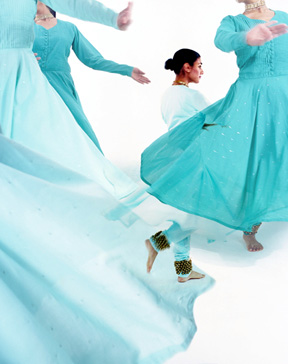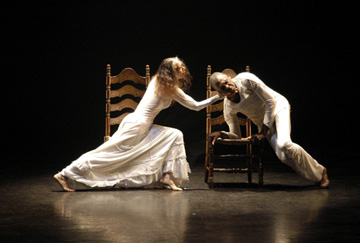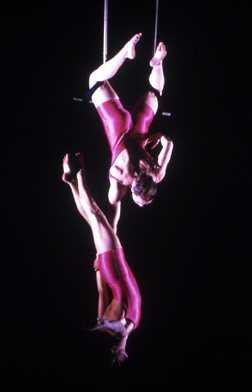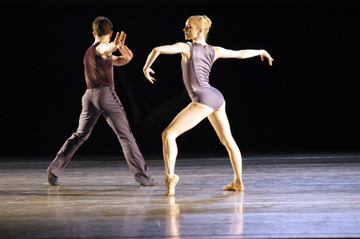Connections
Fall for Dance Festival
City Center
New York, New York
September 28, 29, 30; October 1, 2, and 3, 2004
By
Nancy Dalva
copyright
© 2004 by Nancy
Dalva
published October 4, 2004

Some of it will drive you nuts, because, as the festival producer, City Center President and CEO Arlene Shuler writes in her program welcome, the "programs have been created so there will be something for everyone—dance aficionados and first-time dance goers alike." Obviously, no one person is everyone, and some of the thirty works won't be your thing. ( I, for example, have no interest whatsoever in dance as social anthropology, though formal excellence of any kind appeals to me, and thus I adored Parul Shah and Dancers, whose work is based on Kathak dance.) Actually, despite the credo, it felt more as if there were something from everyone, and from everywhere, than something for everyone on these programs. (And anyway, I would demur from the notion that neophytes must be appealed to with what's obvious.) There also was a boiler-plate-ish-ness to the evenings which was altogether understandable, but did suggest a truly dedicated political correctness as a driving force in the programming.

Over several nights, you could see the Martha Graham Dance Company, and see the companies of Merce Cunningham and Paul Taylor, both of whom danced with Graham and thence rebelled, to form their own companies. Talk about connections! Further, Taylor danced for Cunningham, and exists in interesting fraternal opposition to him, as Cain to Abel.
Or, you could see Balanchine's "Agon," danced by the Dance Theatre of Harlem. Then you could see the New York City Ballet principal Peter Boal dance an excerpt from "Episodes" made by Balanchine for Paul Taylor, on an evening's collaboration with Graham. (Taylor was with Graham at the time; Balanchine was to subsequently invite him to join New York City Ballet, an invitation he declined.) Then, you could see the Paul Taylor Dance Company dance "Promethean Fire." Again, a through line.

After Elizabeth Streb presented dancers on trampolines, the Merce Cunningham dancers seemed gripped by the gravity of the unsprung floor. Trisha Brown and Garth Fagan each choreographed to jazz, one in cool remove, one in hot pursuit. Eiko and Koma and Yin Mei presented dreamscapes.
There was some rather faux ethnicity, and there was the real deal. On two different nights, two different dancers in different African dance companies lost their tribal skirts—one of grass, one of peacock feathers. PEARSONWIDRIG DANCETHEATER employed real oranges in a mock-Italian entertainment that had moments of rapture. The Sufi tribal dancers from the troupe called Sidi Goma, who are African-Indians from Gujarat, broke coconuts open by bouncing them off their heads.
American Ballet Theatre sent over Paloma Herrera and Jose Manuel Correño, who, being one of the hottest men in town and then some, disabused anyone of the notion that ballet was for wussies. Even hotter, there being a lot of them, were the testosterone-fueled breakers of Rennie Harris PUREMOVEMENT. (Too bad they weren't in the Bill T. Jones!)

"The Boston Ballet," I said to Arlene Shuler at intermission. "Who knew?" "I did," she said triumphantly. And so she did.
Photos:
First: Parul Shah & Dancers.. Photo: Tobias Prasse.
Second: Carmen deLavallade and Gus Solomons jr in Dwight Rhoden's "Paradigm."
Photo: Marta Fodor
Third: Sarah East Johnson, Adrienne Truscott. Photo: Nancy
Brooks Brody.
Fourth: Sarah Lamb, Joel Prouty in Boston Ballet's " Plan to
B". Photo: Eric Antoniou.
www.danceviewtimes.com
Volume 2, No. 37
October 4, 2004
Copyright
©2004 by Nancy Dalva
|
|
|